The Spirit of Detroit

Looking at the vast homes in Palmer Woods- particularly the former Archbishop’s 62-room mansion, I could feel the dream stirring. At various times I have felt it palpably. Staying downtown a couple years ago, I looked at some of the Beaux Arts skyscrapers that are vacant now.
I walked into the Golden Tower of the Fisher Building to investigate the rental of a little office suite to house the corporate headquarters of the Socotra House publishing empire.
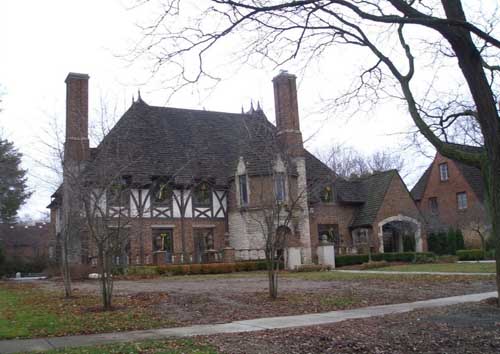
What a prestigious address- I could not have imagined such sumptuous surroundings for what is essentially a Mom and Pop business, or would be if I could find Mom around here someplace. I feel it periodically when I look at some grand structure that has such intrinsic history and worth. And a view to die for, the one in which the relics of the devastated city still seem to be alive.
The RenCen on the River, and in the other direction, out where the curve of the earth becomes apparent, the smaller modern towers constructed by those that fled.
The largest Masonic Temple in the world is not far away, for example, down at the heels, perhaps, but magnificent in its decay. The possibilities…they call out “opportunity,” and more likely, “heartbreak.”
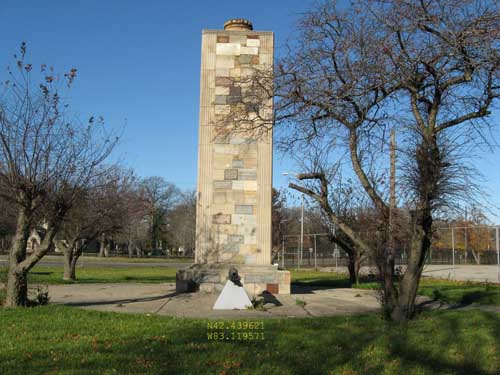
And as we drove away from Palmer Woods onto the curiously silent Woodward Avenue, past the abandoned State Fair Grounds and the vandalized Civil War Monument, headed for Eight Mile. I couldn’t see if the old muzzle-loading cannons were still at the base of the square stone tower, which honored the service of the 24th Michigan infantry, a component of the Iron Brigade, which racked up the highest casualty rates of any unit in the Army of the Potomac. They might have been stolen for scrap. It seemed they were likely targets.
There was a time when an “eternal” flame blazed from the product of a natural gas well drilled nearby, but that was long ago, and the gas better used for heating against the cold of the Michigan winter. I could see a few of the 250 stones that festooned the surface of the monument were gone, victims of the weather and neglect, or souvenir hunters.
We passed through the big underpass that leads Woodward out of the failed urban colossus and into the near suburbs.
The closest of them is Ferndale. It was a gritty blue-collar kind of town, one of the string of pearls strung along mighty Woodward- followed by Pleasant Ridge and Royal Oak and then Grabbingham and Bloomfield Hills before settling again into working class Pontiac, named for the Native American chief who ravaged the early settlers in SE Michigan.
The money used to start somewhere in Royal Oak, mostly at the northern edges, and end at the Pontiac city limits. That is where it went to the north when the city began to change in the 1950s, there and east to the posh Grosse Points.
Grabbingham was solidly middle class with the larger Auto execs in their exclusive enclaves out by the Kirk in the Hills and the Cranbrook Educational Community. The architecture out there was of a piece with Palmer Woods- solid stone and neo-Tudor.
The flight to the suburbs really began in the 1920’s, when Detroit roared like no place else. The Purple Gang had a hideout in Grabbingham, even if much of their business was inside Eight Mile.
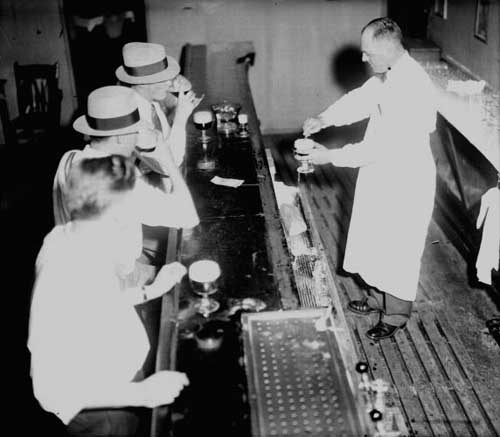
Bootleggers, gangsters, flappers and Feds converged on the Motor City, whose proximity to Canada made it the supplier of three-quarters of the illicit liquor poured in America during Prohibition. If the 1920s could be said to roar in America, you can characterize Detroit as a thundering engine of commerce, legal and not.
Unprecedented revelry could be found with a secret knock at any of the 25,000 blind pigs and speakeasies in the city. Even Mayor John Smith thumbed his nose at the blue-nosers and was once busted at a Mack Avenue juice joint. We were talking about that in the car, and we were headed for a distillery.
The kids had mentioned it at lunch, and I was interested. They tried to explain Ferndale. “It is sort of like Arlington,” they said. “Maybe the Clarendon neighborhood. Royal Oak began to be fashionable first, but now Ferndale is edgy and cool. They narrowed Nine Mile and made it more pedestrian friendly. People are out at night, and when the Dream Cruise happens it is a raucous street party.”
I considered that, and the flickering flame of interest in this place that Anthony Bourdain compared to Chernobyl.
“You will like this place. It is a real distillery. A guy named Rifina Valentine decided to come home after a career on Wall Street and start making booze.”
“I am strongly in favor of that. I have thought about it down in Virginia, but we have a certain history about moonshine. They take it seriously down there, and have since Shay’s Rebellion.”
“Here in Michigan they treat it more like making your own wine.”
“Very progressive,” I said. “And thoroughly in keeping with Detroit’s tradition about liquor.”
We found a place to park the Explorer on Vetter, a quiet side-street on the east side of Woodward just down from the Elk’s Club and a vacant dance studio. Valentine’s is housed in an older brick warehouse structure unadorned with a name- just a red light burning above the door and a sign indicating that the place makes (or made in some distant time) pool-tables.
There were a couple smokers outside, and we walked into the bar room. All exposed enter the bar room which was all exposed brick, with big windows. The bar was small and to our right and the rest of the room was set with high-top cocktail tables. The big wall was decorated with the Valentine’s logo- a spritely scantily clad woman who looked as though she had just climbed down from the nose-art of a B-17 bomber.
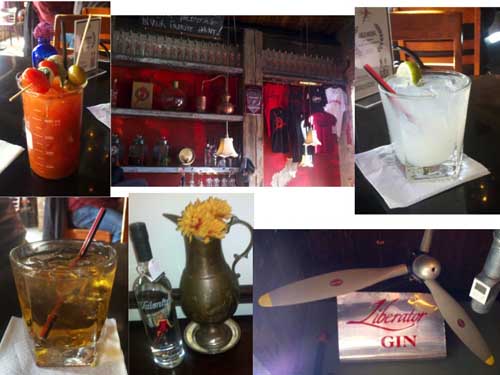
In the rafters the aviation theme continued with a bright aluminum curved metal sign adverting “Liberator Gin” with a giant Pratt and Whitney propeller hanging next to it.
“Appropriate,” I said, walking over to look more closely. “They made more than 5,000 B-24 Liberators at the plant at Willow Run.”
We took a seat at a high top and a formidable woman with jet black hair in a provocative cut and nice ink peaking out of the sleeves of her blouse. She introduced herself as Katie, and said “You folks new here? You want vodka?” The spirit of the Soviet Union and the forerunner of the Premium Liquor movement in Detroit is on the other side of that wall, right here in Ferndale.”
She gestured toward the exposed brick. “It is Sunday, so we have limited snacks. There is some infused Vodka, gin and liquor still available- must be the holiday. And we have our signature cocktails and bloody marys on special.”
“This is too cool,” I said. “Can you get tours of the operation? I am interested in making moonshine down in Virginia.”
“Of course,” she said. “But you will have to be around when the owner is here. He is proud of what he did, bringing in kids with chemistry and biochemistry degrees to make exactly the perfect product. We use old-world techniques and equipment to create a hand-distilled vodka with a proprietary multi-grain blend.”
“So Valentine’s is made from grain, not potatoes, right?” I asked.
“Our position is that potato-based vodka is best left to those who grew up on it. Mr. Valentine’s approach to grain-based vodka has won awards at international competitions for taste and smooth drinkability. Plus, we use local products to enhance the cocktail experience.”
“We are firmly in the local food movement back home,” I said. “And why shouldn’t we drink that way, too?”
“Right on” said Katie. “Our special blend features locally grown Red Michigan wheat, barley and corn. The mash is boiled and fermented one small batch at a time. Then it is triple-distilled to separate the pure vodka. Mr. Valentine then makes the critical decision on where to “cut” the heart of the run based on his trained sense of smell and taste. Then that perfect heart is charcoal-filtered for extra smoothness.”
“Sounds like Mr. Valentine is a master craftsman,” I said. “I like that attention to detail in a fine cocktail.”
“We won the Gold Medal at the San Francisco Spirits Festival in 2012.We scored a 94 out of a hundred, and beat Grey Goose, Belvedere, Ketel One and Tito’s,” she said proudly.
“But we have other great drinks, too. Our Moscow Mules are served in copper mugs and made with Vernor’s Ginger Ale. The locals love them.”
“We only got Vernor’s when we were sick as kids. The taste of it brings back a lot of memories. They used to brew it at the bottling plant at the foot of Woodward.”
She pointed to a drink on the bar that had skewers with little mozzarella cheeses and peppers exploding out of a glass on the bar. “Local is good. We used McClure’s pickles in our Motor City Marys, and craft our other drinks with B. Nektar Meadery and Grocer’s Daughter Chocolates. We also distill a sister brand called Ghost Vodka.”
“Hold the chocolate for me,” I said, “I’ll take a Motor City Mary.”
The kids had opted for the specialty drinks, and Katie swept off to construct them. When she returned, she also brought out little beakers of the whiskey and gin to try. Both were remarkable in their subtlety.
“An unfortunate incident at the end of High School has rendered my relationship with gin problematic.” I wrinkled my nose at the crisp smell of juniper in the beaker, which had no corresponding pungency in the liquor itself. “That is delicious”
Katie smiled. “Since Mr. Valentine launched the brand four years ago, his vodka has found its place in locations throughout Michigan, and he is going to expand to connoisseurs in other states. For the first time since Prohibition, Detroit will be the place that supplies America with its finest spirits.”
We talked about drinks and dreams, since the kids still have them, and finished one drink and prepared to head back up Woodward Avenue. I stopped at the bar to ask Katie for a bottle to go, something that would never occur to me to try down in Virginia.
She slid the elegant clear bottle with the saucy logo into a brown paper bag and handed it over the bar in exchange for some cash, speak-easy style.
“Thanks,” I said. “It is good to see something positive happening. I mean that. The old town will always be special to me, and now I can drink something besides Stroh’s fire-brewed Bohemian Beer. I would like to hang out here, sometime.”
“Come on back,” she said. “But remember, Stroh’s got sold a long time ago. We are the last local. But Ferndale isn’t Chernobyl, you know. That is further down the road.”
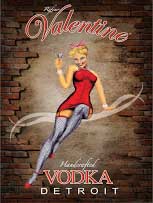
Copyright 20313 Vic Socotra
www.vicsocotra.com
Twitter: @jayare303
web site hosting by renee lasche .com
